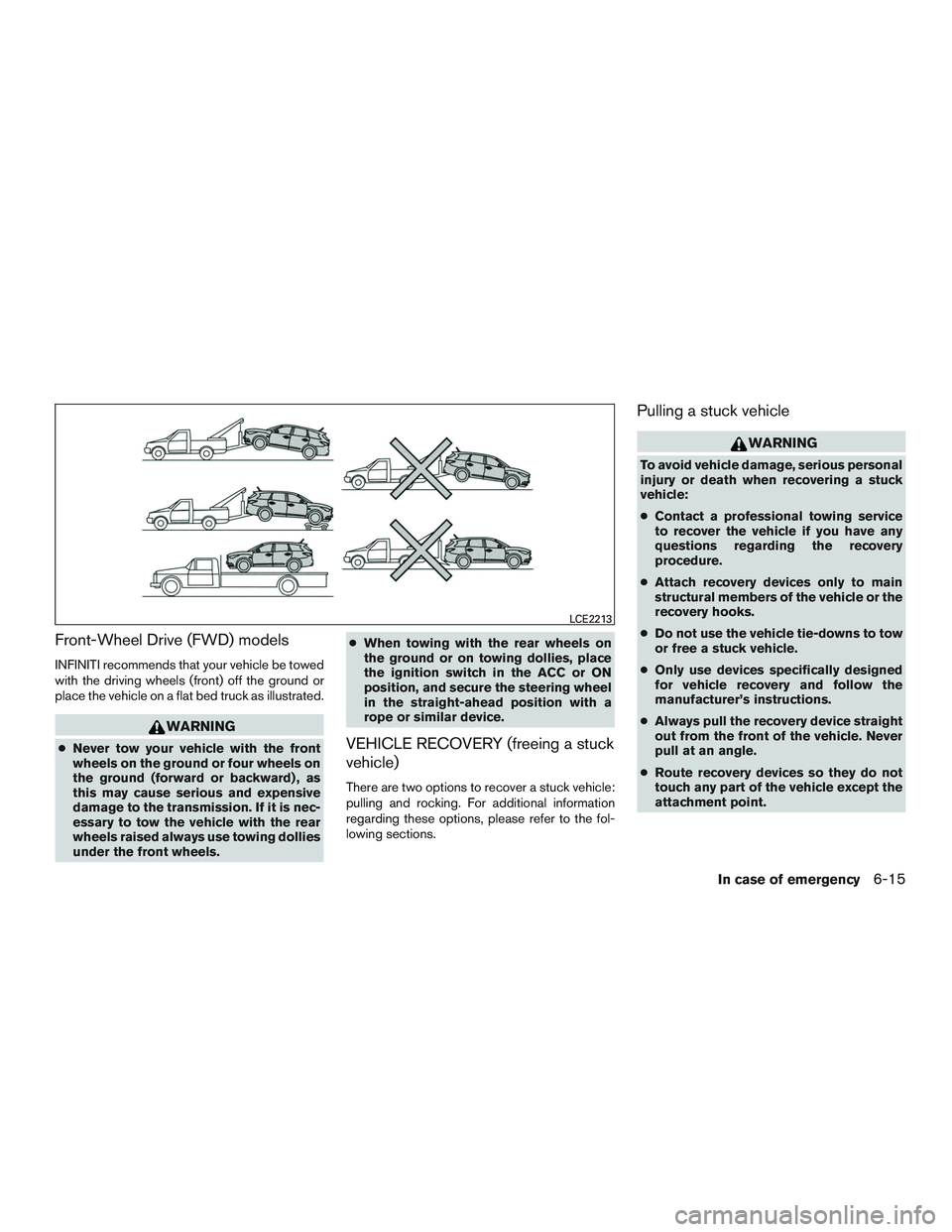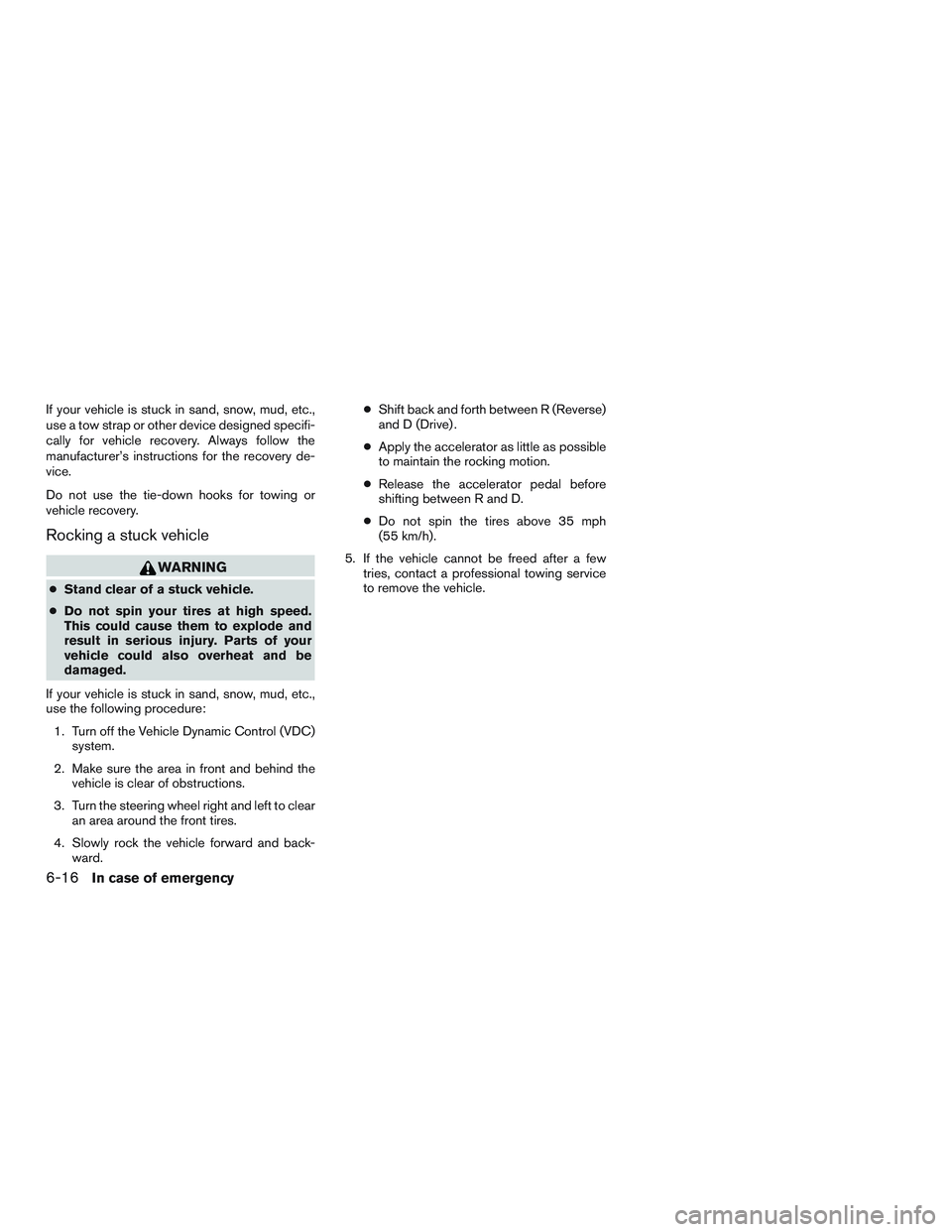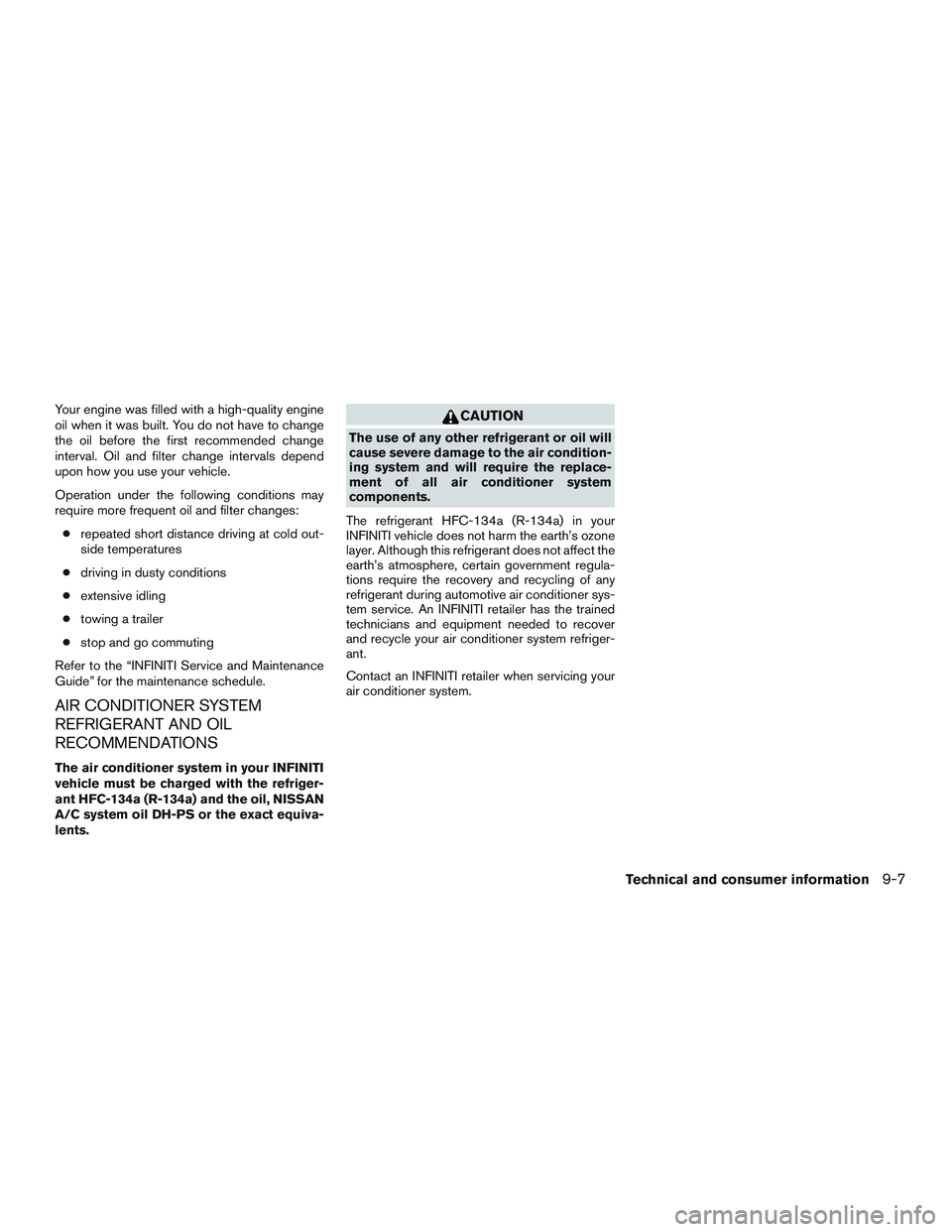Page 426 of 554

– When there is a highly reflective ob-ject near the vehicle ahead (for ex-
ample, being very close to another
vehicle, signboard, etc.)
– When you are towing a trailer.
● Depending on certain road conditions
(curved or beginning of a curve) , vehicle
conditions (steering position or vehicle
position) , or the preceding vehicle’s
conditions (position in lane, etc.) , the
system may not function properly. The
system may detect objects such as
signs and other stationary objects on
the road or near the traveling lane and
provide unnecessary warning.
● The system may not function in offset
conditions.
WARNING
●In extreme conditions, detection of
these objects may cause the system to
function. ●
The system is designed to automatically
check the sensor’s functionality. When
the sensor detects an obstruction of the
radar signals due to dirt, adhesive ma-
terial, or similar objects to the front
bumper, the system will automatically
cancel. However, sensor may not detect
all obstructive material. In these in-
stances the system may not be able to
warn the driver properly. Be sure to
check and clean the sensor area of the
front bumper regularly.
● Excessive noise will interfere with the
warning chime sound, and the chime
may not be heard.
● A sudden appearance of a vehicle in
front (for example, it abruptly cuts in)
may not be detected and the system
may not warn the driver soon enough.
● The system will be cancelled automati-
cally with a beep sound and the IBA
warning light will illuminate under the
following conditions:
– When the sensor area of the front bumper is dirty
– When the system malfunctions
Reflectors on the road
LSD2021
Starting and driving5-87
Page 446 of 554
6 In case of emergency
Hazard warning flasher switch......................6-2
Roadside assistance program .......................6-2
Emergency engine shut off .........................6-3
Flat tire ...........................................6-3
Tire Pressure Monitoring System (TPMS) ..........6-3
Changing a flat tire .............................6-4 Jump starting
.................................... 6-10
Push starting ..................................... 6-12
If your vehicle overheats ........................... 6-12
Towing your vehicle ............................... 6-13
Towing recommended by INFINITI ...............6-13
Vehicle recovery (freeing a stuck vehicle) .........6-15
Page 458 of 554

6. After the engine cools down, check the cool-ant level in the engine coolant reservoir tank
with the engine running. Add coolant to the
engine coolant reservoir tank if necessary.
Have your vehicle repaired at an INFINITI
retailer. When towing your vehicle, all jurisdictions and
local regulations for towing must be followed.
Incorrect towing equipment could damage your
vehicle. Towing instructions are available from an
INFINITI retailer. Local service operators are gen-
erally familiar with the applicable laws and proce-
dures for towing. To assure proper towing and to
prevent accidental damage to your vehicle,
INFINITI recommends having a service operator
tow your vehicle. It is advisable to have the ser-
vice operator carefully read the following precau-
tions:
WARNING
●
Never ride in a vehicle that is being
towed.
● Never get under your vehicle after it has
been lifted by a tow truck.
CAUTION
●When towing, make sure that the trans-
mission, axles, steering system and
powertrain are in working condition. If
any of these conditions apply, dollies or
a flatbed tow truck must be used.
● Always attach safety chains before
towing. For additional information about towing your ve-
hicle behind a recreational vehicle (RV) , refer to
“Flat towing” in the “Technical and consumer
information” section of this manual.
TOWING RECOMMENDED BY
INFINITI
INFINITI recommends towing your vehicle based
upon the type of drivetrain. Please refer to the
diagrams in this section to ensure that your ve-
hicle is properly towed.
TOWING YOUR VEHICLE
In case of emergency6-13
Page 459 of 554
All-Wheel Drive (AWD) models
INFINITI recommends that towing dollies be used
when towing your vehicle or the vehicle be
placed on a flat bed truck as illustrated.
CAUTION
Never tow AWD models with any of the
wheels on the ground as this may cause
serious and expensive damage to the
powertrain.
LCE2212
6-14In case of emergency
Page 460 of 554

Front-Wheel Drive (FWD) models
INFINITI recommends that your vehicle be towed
with the driving wheels (front) off the ground or
place the vehicle on a flat bed truck as illustrated.
WARNING
●Never tow your vehicle with the front
wheels on the ground or four wheels on
the ground (forward or backward) , as
this may cause serious and expensive
damage to the transmission. If it is nec-
essary to tow the vehicle with the rear
wheels raised always use towing dollies
under the front wheels. ●
When towing with the rear wheels on
the ground or on towing dollies, place
the ignition switch in the ACC or ON
position, and secure the steering wheel
in the straight-ahead position with a
rope or similar device.VEHICLE RECOVERY (freeing a stuck
vehicle)
There are two options to recover a stuck vehicle:
pulling and rocking. For additional information
regarding these options, please refer to the fol-
lowing sections.
Pulling a stuck vehicle
WARNING
To avoid vehicle damage, serious personal
injury or death when recovering a stuck
vehicle:
●Contact a professional towing service
to recover the vehicle if you have any
questions regarding the recovery
procedure.
● Attach recovery devices only to main
structural members of the vehicle or the
recovery hooks.
● Do not use the vehicle tie-downs to tow
or free a stuck vehicle.
● Only use devices specifically designed
for vehicle recovery and follow the
manufacturer’s instructions.
● Always pull the recovery device straight
out from the front of the vehicle. Never
pull at an angle.
● Route recovery devices so they do not
touch any part of the vehicle except the
attachment point.
LCE2213
In case of emergency6-15
Page 461 of 554

If your vehicle is stuck in sand, snow, mud, etc.,
use a tow strap or other device designed specifi-
cally for vehicle recovery. Always follow the
manufacturer’s instructions for the recovery de-
vice.
Do not use the tie-down hooks for towing or
vehicle recovery.
Rocking a stuck vehicle
WARNING
●Stand clear of a stuck vehicle.
● Do not spin your tires at high speed.
This could cause them to explode and
result in serious injury. Parts of your
vehicle could also overheat and be
damaged.
If your vehicle is stuck in sand, snow, mud, etc.,
use the following procedure: 1. Turn off the Vehicle Dynamic Control (VDC) system.
2. Make sure the area in front and behind the vehicle is clear of obstructions.
3. Turn the steering wheel right and left to clear an area around the front tires.
4. Slowly rock the vehicle forward and back- ward. ●
Shift back and forth between R (Reverse)
and D (Drive) .
● Apply the accelerator as little as possible
to maintain the rocking motion.
● Release the accelerator pedal before
shifting between R and D.
● Do not spin the tires above 35 mph
(55 km/h).
5. If the vehicle cannot be freed after a few tries, contact a professional towing service
to remove the vehicle.
6-16In case of emergency
Page 512 of 554

9 Technical and consumer information
Recommended fluids/lubricants and capacities.......9-2
Fuel recommendation ...........................9-4
Engine oil and oil filter recommendations ..........9-6
Air conditioner system refrigerant and oil
recommendations ..............................9-7
Specifications .....................................9-8
Engine ........................................9-8
Wheels and tires ...............................9-9
Dimensions and weights ........................9-9
When traveling or registering your vehicle in
another country .................................. 9-10
Vehicle identification .............................. 9-10
Vehicle identification number (VIN) plate .........9-10
Vehicle identification number
(chassis number) .............................. 9-10
Engine serial number ........................... 9-11
F.M.V.S.S./C.M.V.S.S. certification label ..........9-11
Emission control information label ...............9-11
Tire and loading information label ................9-12Air conditioner specification label
................9-12
Installing front license plate ........................9-13
Vehicle loading information ........................9-14
Terms ........................................ 9-14
Vehicle load capacity .......................... 9-15
Securing the load .............................. 9-17
Loading tips .................................. 9-17
Measurement of weights .......................9-18
Towing a trailer ................................... 9-18
Maximum load limits ........................... 9-19
Towing load/specification .......................9-22
Towing safety ................................. 9-22
Flat towing .................................... 9-29
Uniform tire quality grading ........................9-29
Emission control system warranty ..................9-30
Reporting safety defects .......................... 9-31
Readiness for inspection/maintenance (I/M) test .....9-32
Event Data Recorders (EDR) (if so equipped) ........9-32
Owner’s Manual/Service Manual order information . . . 9-33
Page 518 of 554

Your engine was filled with a high-quality engine
oil when it was built. You do not have to change
the oil before the first recommended change
interval. Oil and filter change intervals depend
upon how you use your vehicle.
Operation under the following conditions may
require more frequent oil and filter changes:● repeated short distance driving at cold out-
side temperatures
● driving in dusty conditions
● extensive idling
● towing a trailer
● stop and go commuting
Refer to the “INFINITI Service and Maintenance
Guide” for the maintenance schedule.
AIR CONDITIONER SYSTEM
REFRIGERANT AND OIL
RECOMMENDATIONS
The air conditioner system in your INFINITI
vehicle must be charged with the refriger-
ant HFC-134a (R-134a) and the oil, NISSAN
A/C system oil DH-PS or the exact equiva-
lents.
CAUTION
The use of any other refrigerant or oil will
cause severe damage to the air condition-
ing system and will require the replace-
ment of all air conditioner system
components.
The refrigerant HFC-134a (R-134a) in your
INFINITI vehicle does not harm the earth’s ozone
layer. Although this refrigerant does not affect the
earth’s atmosphere, certain government regula-
tions require the recovery and recycling of any
refrigerant during automotive air conditioner sys-
tem service. An INFINITI retailer has the trained
technicians and equipment needed to recover
and recycle your air conditioner system refriger-
ant.
Contact an INFINITI retailer when servicing your
air conditioner system.
Technical and consumer information9-7